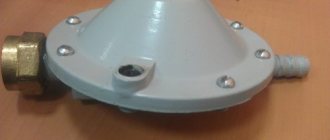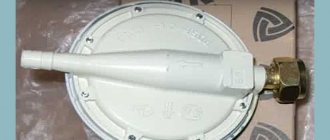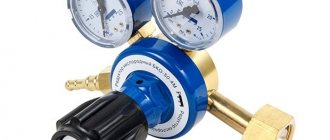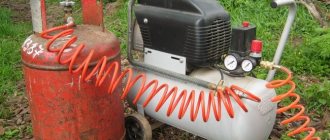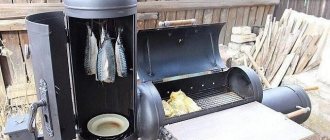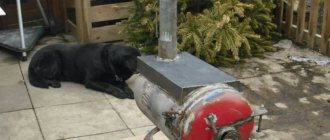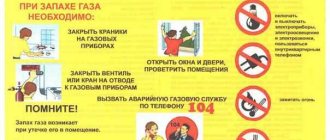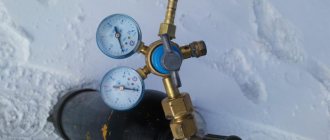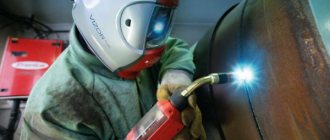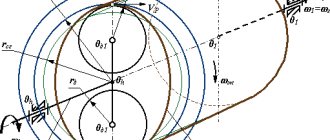Not all settlements and dacha areas are connected to the centralized gas supply. Unfortunately, there are still towns and villages in which bottled gas is actively used. For its safe use, a gas reducer is required - a device that reduces the fuel pressure to the values required for stoves and boilers.
We will tell you everything about the guidelines for choosing a reduction device. The information we provide will help you buy the most suitable reducer for installation on a gas cylinder. We describe in detail the types of devices and the criteria according to which preference should be given to a particular model.
Those wishing to independently install and connect the reduction device will be helped by the detailed step-by-step instructions. Here you will find rules, compliance with which will protect you and extend the service life of gas installations. The article is illustrated with photographs and supplemented with video tutorials.
Purpose of the gas reducer:
- Decreased pressure. The standard pressure at the inlet of a gas cylinder varies in the range of 150-250 atmospheres. With the help of a gas reducer, this output value is reduced to 1-16 atmospheres. There are also modifications that maintain outlet pressure up to 70 atmospheres.
- Maintaining constant pressure. The reducer allows you to prevent a drop in equipment power when the pressure inside the tank decreases. Thanks to this, it is possible to carry out all the necessary work even when filled to 5-10% of the maximum volume. But for this you need to buy a gas cylinder with a reverse-action reducer.
- Preventing air from entering the cylinder. Propane, butane, methane, hydrogen and acetylene, when mixed with air, form an explosive mixture that ignites even from the slightest spark. To increase the level of fire safety, it is strongly recommended to use containers with a reliable valve. This is especially true when refilling gas cylinders with propane or methane.
- Can function as a pressure relief valve. If the operating pressure increases to critical values, excess gas may be released. This helps prevent equipment damage and explosion during operation of the gas cylinder.
- Improves overall system reliability. The reducer is designed specifically to increase safety when using gas equipment. Helps prevent container rupture and gas explosion.
Malfunctions. Repair.
If you decide to carry out repairs or adjustments yourself, make sure you have the necessary qualifications. Poor repair of gas equipment can cause a fire, explosion or poisoning. After completing the work and assembly, make sure that the device is tight and operates correctly. The tightness is checked by applying a soap solution to all joints. No bubbling indicates there is no leak. But you shouldn’t delude yourself. The tightness will need to be checked several more times (after a day, three days, a week of operation), and then checked regularly, since a leak may occur some time after the start of operation.
Main malfunctions: the gas pressure at the outlet does not correspond to the nominal value (reason: the spring is broken or deformed), gas leakage (reasons: the membrane is damaged, the tightness of the connection between the membrane and the housing is broken, the float valve is leaking)
Here is a selection of materials:
IN
Everything you need to know about heating and climate control Features of the selection and maintenance of boilers and burners. Comparison of fuels (gas, diesel, oil, coal, wood, electricity). Do-it-yourself ovens. Coolant, radiators, pipes, heated floors, circulation pumps. Chimney cleaning. Conditioning
If the float bypass valve leaks, then the leak may not occur in the reducer itself, but somewhere further, for example, in a gas stove, since in this case, in zero consumption mode (when the stove or some other consumer is turned off), at the outlet reducer and gas pipes, the pressure can reach the inlet pressure. Gas gradually leaks through the valve, and there is nowhere for it to go. If there is a gas cylinder at the inlet, the pressure can reach 15 bar, which is 500 times higher than the nominal one. Such pressure will definitely lead to leakage. At the same time, it is difficult to detect this malfunction, since when the stove is turned on, the pressure normalizes. There is no sign of overpressure (flame blowout). The fault can only be identified by measuring the outlet pressure in zero consumption mode. It can be no more than 20% more than nominal.
To repair, the gearbox must be disassembled. Only a dismountable gearbox with a spring can be repaired. Sealed gearboxes are not suitable for repair.
In the picture, the membrane is with the bottom side up.
An inspection will show if there are defects in the membrane or a broken spring. A torn membrane can be replaced. But it’s not worth it, it’s better to buy a new gearbox, since it’s quite difficult to hermetically connect the new membrane with the washers. A broken spring can be replaced. Most often, the spring does not break, but simply compresses a little over time. As a result, the outlet pressure becomes lower than nominal. This malfunction can be easily corrected by placing a gasket between the housing and the spring. Read about this below in the section on transferring to another pressure.
Membrane - top view.
If you have diagnosed problems with the bypass valve, then you need to inspect it. It is a tube with a thin hole. A piece of hard rubber mounted on a rocker arm is pressed against the end of the tube. The valve may not close for the following reasons: Firstly
, the mobility of the rocker arm is impaired.
Move it with your hands, make sure it moves freely. If there are problems, grind or replace the hinges. Secondly
, a piece of rubber was worn out and torn.
It can be removed with a sharp knife and replaced by gluing another one of the appropriate size in its place. Thirdly
, the end of the inlet tube may not be smooth, with damage and roughness. This prevents a tight seal. The end can be sanded with fine sandpaper.
Very often, a leak occurs due to a leak in the seal between the membrane and the lower part of the housing. Troubleshooting is easy. You need to lubricate the edge of the lower part of the case where the membrane fits with silicone sealant, let it dry a little (10 minutes), install the membrane, assemble the gearbox and let it dry a little more (2 hours).
During disassembly and subsequent reassembly, it is quite easy to break the tightness of the membrane. If you have disassembled the gearbox, then during reassembly in any case, even if there was no leakage, use silicone sealant. This will improve reliability.
Classification of gas regulators
| Model | Inlet pressure | Outlet pressure | Gas consumption | Availability of adjustment | Availability of pressure gauge |
| RDSG 1-0.5 Belarus | 0.07-1.6 MPa | 2000-3600 Pa | 0.5 m3/hour | No | No |
| RDSG 1-1.2 | 0.07-1.6 MPa | 2000-3600 Pa | 1.2 m3/hour | No | No |
| Milano under eyeliner | 0.03-0.75 MPa | 1960-5880 Pa | 1.5 m3/hour | Yes | No |
| Milano under the sleeve | 0.03-0.75 MPa | 1960-5880 Pa | 1.5 m3/hour | Yes | No |
| Italy 694 | 1.6 MPa | 2900 Pa | 1.5 m3/hour | No | No |
| Italy 694 d/composite cylinders | 1.6 MPa | 3700 Pa | 1.5 m3/hour | No | No |
| RDSG 1-1.3 China | 0.07-1.6 MPa | 2000-3600 Pa | 1.3 m3/hour | No | Yes |
| RDSG 1-0.5 China | 0.07-1.6 MPa | 2000-3600 Pa | 0.5 m3/hour | No | Yes |
| GOK EN-61 | 1.6 MPa | 3700 Pa | 1.5 m3/hour | No | No |
| GOK for composite cylinders | 1.6 MPa | 2900 Pa | 1.5 m3/hour | No | No |
Characteristic
- Oxygen - designed to regulate the supply of oxygen in the cylinder. Common markings: SKO - 10-2, BKO - 50 mini, RK-70, RKZ - 500-2. Painted blue, secured with union nuts. Capacity from 10 to 500 m3/hour. The price varies from 1600 to 21500 rubles.
- Propane - regulates the supply of propane. Markings: BPO - 5, SPO - 6, RDSG-1-MTL (frog). Painted red, secured with union nuts. Throughput from 1.5 to 1.6 m3/hour. Price – from 400 to 1600 rubles.
- Carbon dioxide - to regulate the supply of carbon dioxide. Markings: UR-6-6, BUO-5-4. Can be painted black or red and blue. Fastened with union nuts. Capacity 5-6 m3/hour. Price 900-1500 rubles.
- Acetylene - regulate the supply of acetylene. Markings: BAO-5-4, RAO-30-1, SAO - 10. Fastened with clamps. Painted white. They pass from 5 to 30 m3/hour. Price from 1600 to 14300 rubles.
- Argon. Markings are: AR-40-4DM, AR-40-KR1-mr. Color white or black. They pass 1.8-5.4 m3/hour. Price 1400-1750 rubles.
- Helium. For helium regulation. Marked: G-70-KR1, G-70-KR1-m. Fastened with nuts. Color white or black. Bandwidth 4.2. Price about 1500.
throughput (highest value) m3/h
gas pressure at the inlet, (maximum value) MPa (kgf/cm2)
operating gas pressure, (maximum value) MPa (kgf/cm2)
Source
Operating principle of the gearbox
The device is connected to a gas cylinder using a union nut, the thread on which is strictly defined: Sp21.8LH (left). This is done in order to exclude the possibility of connecting a gearbox for other equipment. The connecting nut is made of brass and is necessarily equipped with a transition projection, which prevents possible gas leaks. When using propane cylinders manufactured according to the European standard KLF with an already installed sealing ring and a filter on the fitting, you will also need a special adapter.
A propane reducer works like this. The gas from the cylinder first passes through a mesh filter, from where it enters the lower chamber at high pressure. Next, the required operating pressure is adjusted. To do this, the adjusting screw is rotated clockwise, acting on the set spring. The spring pushes the pressure plate, and through the reducing spring, pusher and diaphragm transmits force to the reducing valve. It opens, and through the gap between the valve and its seat, it opens the way for propane into the working chamber. A low pressure gauge is used to monitor the actual gas pressure. In order to connect the hose of a roofing torch, cutter or other unit to the device, an outlet connecting nipple is provided. For connection, a union nut with an M16×1.5LH thread is usually used.
When gas is supplied under initial pressure, the following occurs: the membrane closes the inlet valve (the level of pressure required for this depends on the area of the membrane, its diameter and the setting of the drive spring). The level of propane pressure at the outlet of the reducer depends on the degree of blocking of the hole. Since the membrane moves abruptly when high-pressure gas is supplied, household gas reducers of this type are often called “frog”. “Frog” is a typical representative of a propane reducer, which is used to supply gas to simple household devices. Unlike the above-mentioned devices BPO 5-3, BPO 5-4, etc., the “frog” does not have a unit for adjusting the inlet gas pressure, and its performance is determined solely by the physical and mechanical characteristics of the membrane material. Therefore, such gearboxes are designed for use strictly in the conditions that are specified, as a rule, they have reduced operational capabilities (in particular, flow rate and outlet pressure), but are more compact and have a lower price (290 ... 350 rubles versus 450 ... 700 rub. - for single-chamber devices or 1200...1300 rub. - for two-chamber devices). The “frog” can be connected using a clamp.
Installation features
As you know, gas should be handled with extreme caution due to its explosive hazard, because even a small leak or poor-quality connection can lead to extremely tragic consequences.
Connecting bottled gas to the stove should not occur in the absence of one of the following elements:
A stove designed for the use of liquefied gas (as a rule, when connecting equipment designed for pressure from a centralized network, the burners burn poorly with a characteristic yellowish flame color).
In this case, both a special stove for a summer house under a cylinder and replacement of the jets of the old tiles with special ones for liquefied gas are suitable.
Container with propane-butane mixture.
Gearbox. This unit is necessary to equalize gas pressure while gradually reducing the amount of mixture in the cylinder.
Gas hose made of flexible rubber or semi-flexible bellows hose. According to SNiP standards, the cylinder is installed no closer than 1 m relative to the stove or heating appliances.
In this case, the hose should be positioned freely, without tension. Therefore, you will need to purchase it about a meter more than required.
Connecting elements. Fittings and screw clamps for rubber hose.
In the case of using bellows hoses, use threaded adapters.
Soap solution to check for possible gas leaks after installation is completed.
Step by step guide
If you already have everything necessary for installation, then it’s time to tell you how to connect a gas cylinder to the stove with your own hands:
Step 1. Connect to the stove
The gas stove must already be installed in its place before connecting:
- We connect a hose to the outlet pipe of the stove, screwing it onto the pipe hole and tightening it with a clamp.
- In the case of using threaded adapters, it is enough to screw them tightly onto the pipe threads, having previously wound the non-metallic tape onto the threads.
- All manipulations are carried out without a connected cylinder, that is, the other end of the hose is not connected to it.
Step 2. Connecting the gas reducer
When using gas household appliances that receive fuel from a centralized gas supply system, the presence of this element is not necessary. However, the use of liquefied gas in cylinders requires a reducer to equalize the pressure of the outlet flow:
- The reducer is installed using an adapter at the outlet of the gas cylinder; the use of sealing fum tape is mandatory.
- A gas hose is installed at the outlet of the reducer, which is secured with a clamp.
Step 3. Installing the cylinder
The location of the cylinder must comply with all regulations and safety requirements. It can be installed either in the room where the stove is located, or in a neighboring one, or in a specialized box on the street or in a utility room.
To properly install the cylinder, the following conditions must be met:
- Do not install equipment in basements, basements, semi-basements, or buildings higher than two floors.
- The distance from heating appliances and gas stoves should not be less than 1 m.
- A metal cabinet for a cylinder located outdoors must protect it not only from precipitation and sunlight, but also from freezing, therefore it must be insulated and heated.
- The cylinder must be placed on a flat, clean, dry surface. If this is the floor in a special cabinet, then the cylinder itself is installed on a pallet or slats, not on the bottom itself.
Step 4: Check for Leaks
The connection of the cylinder to the stove is checked using a concentrated soap solution:
- Prepare a solution of soap and warm water, beat until light foam.
- Using a sponge or cloth, apply the solution to the junction of the gas hose and all elements.
- If soap bubbles appear, there is a leak. Otherwise, you did everything right.
If you can verify that the connection is tight, set the required pressure on the reducer and slightly open the cylinder screw to let gas into the system.
We turn on the burners and evaluate the color and quality of the flame: if it is bluish-green and even, then the pressure is normal.
You can connect a gas stove to several cylinders at the same time using a connecting ramp.
Useful tips
To ensure that the installation of a gas pipeline is as safe as possible, it would be useful to know some useful tips:
Frost-resistant gas mixtures
- can be refilled into cylinders stored outside or in unheated rooms (however, the price and demand during the season will be much higher).
The frost-resistant mixture does not require insulation and evaporates at air temperatures down to -40 °C
Sequence of installation and use
A propane reducer of any type and design is considered a high-risk technique, therefore, when installing it, a number of mandatory requirements must be observed:
- The room (if the gearbox is mounted to an internal consumer) is thoroughly ventilated. Moreover, the window/vent must remain open throughout the entire duration of the initial start-up.
- The correct sequence for using the device is as follows: first, the valve on the propane cylinder opens smoothly. Then the valve of the reducer opens and only then the valve of the gas-consuming equipment. By rotating the adjusting screw handwheel, the required level of operating pressure is set. Disabling is done in reverse order. When extraneous sounds appear - clicks, hissing, etc. - the equipment is immediately turned off.
- After establishing a stable flow of gas through the reducer, monitor the readings of the pressure gauge needle, which should not deviate more than the pressure fluctuation values indicated in the passport. Otherwise, the use of the technology is stopped. A slow increase in gas pressure is considered especially dangerous.
- Once every 2...3 months, the tightness of all connections is checked, and if necessary, the threaded fasteners are tightened.
- If routine maintenance of the propane reducer is necessary - purge the valve - the device is disconnected from the gas main, after which the remaining gas is released from all working cavities of the device. All subsequent operations are performed only in special workshops that have test benches.
- After finishing use, the inlet valve on the gearbox is closed all the way. In this case, the binding of the spring is eliminated, and its performance increases.
- To comply with fire safety rules, it is advisable to provide flame extinguishing devices between the gearbox and the gas-consuming installation.
https://youtube.com/watch?v=lspIr9UNH7E
The use of bottled gas requires a thorough approach to ensuring safety and ease of use. We propose to consider the simplest example of connecting a propane cylinder to a gas stove: connection diagram, shut-off and control valves, organization of storage conditions.
Direct gas equipment
Gas enters the high-pressure chamber through the fitting and acts on the valve to open it. The reducing valve is pressed against the seat by means of a locking spring, thereby preventing access to high pressure gas.
The purpose of the membrane is to remove the reducing valve from the seat and provide access for high pressure gas to the working (low) pressure chamber. That is, two directly opposite forces act on the membrane.
On one side, a pressure spring presses on the membrane through a pressure screw to open the pressure reducing valve. And from the gearbox chamber (from the inside) low pressure gas acts on the membrane.
When the pressure in the working chamber decreases, the pressure spring straightens, the valve moves away from the seat and a new portion of gas enters the chamber.
What is a propane reducer?
The design of all propane reducers is very similar. They all have:
- Sealed housing made of aluminum, brass or plastic.
- Inlet pipe for connection to the cylinder.
- Outlet pipe for connection to the consumer.
- High and low pressure chambers.
- Flexible membrane.
- Valve and stem.
- Return spring.
- Working spring.
In professional gas reducers, a pressure gauge, an adjusting screw or flywheel, and a threaded connection of the supply pipe are added to the design. The gearbox housing has a cylindrical shape, which is due to the use of a round membrane that bends inside the operating pressure chamber. The inlet and outlet pipes protrude from the housing.
Adjustable reducer for gas cylinder
Adjustable gas reducers operate on the same physical principles as non-adjustable ones and have a similar design. The difference is that the compression force of the reducing spring supporting the membrane can be changed using an adjusting screw coaxial with the spring in the simplest models, or using a flywheel and a more complex mechanical transmission.
Adjustable reducer for gas cylinder
The principle of operation is that by changing the pre-compression force of the reduction spring, the user changes the threshold gas pressure in the working chamber required to operate and close the intake valve. A pressure gauge is also added to the parts, installed on the working pipe and allowing you to visually monitor the result of the adjustment.
Design features and maintenance
According to their design, gearboxes differ into direct and reverse acting devices. The differences between them are in the design details, the performance characteristics are identical.
Design of gearboxes for a gas cylinder
In addition, gas reducers are used in single-stage and two-stage types. In single-stage, the pressure is reduced in one stage. In a two-stage reduction, the reduction is carried out in two steps. Balloon single-stage reducers are most widely used due to their reliable design and ease of use.
System connection standards
Devices that support two standards for connecting the reducer to a gas cylinder are widespread:
- GOST - common in the CIS countries, used on locally produced steel cylinders.
- GLK is a European standard, used primarily on composite cylinders.
Connecting the reducer to the gas cylinder
To connect the working pipe:
- Threaded connection.
- Nipples 6.3 or 9 mm.
- Universal nipple.
- GLK.
Some gas reducers, for example, RGDS, are equipped at the factory with a 9 mm nipple pressed into the housing.
Reducers with adjustable operating pressure are equipped with a threaded half-inch outlet, which can optionally be secured with a union nut and a universal nipple.
It is safer to use devices that match the standard. Each adapter is an additional connection that increases the risk of gas leakage.
Installation and configuration of the gearbox
Installation of the gearbox is carried out only by specialists . You can regulate the operation of the device yourself if you strictly follow the instructions.
Cylinder reducers are mounted on the cylinder body. The regulator attaches directly to the outlet via an adapter. The degree of tightening of the screw on the adapter ensures sealing. A flexible gas hose no longer than 3 m . The hose is connected to the stove or boiler.
ValeraVoice of a construction guru It is prohibited to splice, pinch or twist hoses. You can only use special products; water or oxygen models are not suitable.
System connection standards
Connection of the device is regulated by 2 standards :
- GOST – used in the CIS countries, designed for steel cylinders;
- GLK is a European standard, used for the operation of composite cylinders.
Some gearbox models are equipped with a 9 mm press-fit nipple. This makes installation easier.
Adjustment
Adjustment of the gas reducer is only possible on models equipped with an adjusting screw or flywheel . In this case, the compression force of the spring acting on the membrane can be changed. In this way, the threshold pressure in the working chamber is reduced or increased. This changes the closing and opening parameters of the intake valve.
Adjustment is made by turning the nut . It is easier to do this if the cylinder is equipped with a pressure gauge on the working pipe: the pressure in the supplied mixture is reflected on the dial.
Area of application of devices
Wherever there is no stationary gas distribution, people use propane in cylinders. And each cylinder is connected to one or another reducer. The most popular applications are:
Using the gearbox for soldering and welding
- Household and portable stoves and grills.
- Gas water heaters and heat guns for heating rooms.
- Thermal umbrellas for heating recreation areas.
- Gas cutters and welding torches.
- Fuel for land and river transport.
In many countries, wide gas distribution networks have been created to ensure recharging and delivery of gas cylinders to consumers.
The gas cylinder reducer ensures safe and stable operation of gas consuming devices.
If you find an error, please select a piece of text and press Ctrl+Enter.
Liquefied gas, which is used to fill cylinders for subsequent use, is always under increased pressure. To lower it, it is necessary to install a special type of shut-off and distribution valves on the cylinder - a propane reducer. Subsequently, the reducer automatically maintains the specified level of gas pressure. According to safety regulations, the device is always painted bright red - the same color as propane cylinders.
Precautionary measures
Household gas is very dangerous. The main threats posed by propane are:
- Fire hazard.
- Unsuitable for breathing.
- Explosion hazard when the maximum concentration of propane in the air is reached, as well as when the temperature in a closed volume rises sharply.
- During a gas leak, the temperature drops sharply and frostbite is possible.
To preserve the life and health of people and their property, precautions should be taken:
Rules for using gas
- Avoid proximity to open flames and heat sources.
- Avoid the presence of other flammable materials in the work area.
- Eliminate the presence of nitrates and perchlorates near gas equipment due to their chemical activity.
- Do not use the reducer for a propane cylinder if it is damaged or leaking.
Specifics
As already noted, gearboxes can be domestic and industrial. Also universal models.
Consumer versions may not be customizable.
These are simple models. They are used in everyday life and outdoors. RDSG products are installed together with household gas cylinders. They have a very simple design. Due to this, gas can only be used in household stoves. These products are inexpensive and very reliable. There is also a Frog type gearbox, there is the RDSG-1 model. They should only be used in cylinders with a volume of 12 - 50 liters.
The class of universal, customizable gearboxes has a more complex design and greater potential. This is an excellent option for domestic use and for work in the home workshop. The products are attached to the cylinders using a threaded method and are fixed securely.
They have a pressure gauge and an adjustment screw that allows you to vary the functional pressure within the range of 0 - 0.3 MPa. Their highest throughput capacity is 5 m3/hour.
The category of professional models is created from the best wear-resistant materials. They have the highest build quality and settings: 0.4 - 1.6 MPa.
Some modifications have two pressure gauges. They reflect input and functional pressure.
Often, many summer residents and hikers ask questions such as: is a reducer needed for a gas burner? And is a gearbox needed for a gas stove in the country? Stable and safe operation of any gas appliances and in any conditions is always necessary. Even if there is no urgent need for gearboxes, it won’t hurt to be on the safe side. It remains to decide which gearbox is needed for the gas stove.
Since the stove and burner are propane based, a propane reducer is needed. You need to select these products by studying them and comparing their characteristics. The key ones are:
- Purpose of the device.
- Higher inlet pressure.
- Functional pressure.
- Higher gas consumption.
- Attachment method.
- Planned operational life.
- Price.
For example, if you plan to connect a desktop portable stove only on weekends, the gas consumption according to your calculations is 5 liters per month, then you need a 5 liter capacity and a Baltika RDSG-2 reducer.
For a static stove with an oven, a capacity of 27 or 50 liters is required. A suitable gearbox is the Frog RDSG-2.
Questions often arise here - what does a Frog gas reducer actually do? Why is it named like that? What is its purpose?
Why do you need a frog gas reducer? Its functions, like those of other gas reducers, are pressure stabilization, safety, etc.
Why frog? This device is direct. In it, gas flows through a fitting. The valve opens and is pressed against the seat by a spring. High pressure gas does not penetrate into the chamber. The diaphragm displaces the valve from this seat. The pressure gradually decreases to the operating values of the device to which the reducer is mounted.
The spring straightens. The valve is detached from the seat and does not interfere with gas flow. As the pressure increases, the spring presses the valve again, gas does not flow. This principle is reminiscent of frog jumping. And the device is similar in shape to it.
If it is necessary to connect a composite container to a thermal umbrella, it is better to use imported products with a KLF connector
The professional model BPO 5-3 Krass is optimally suited for gas welding in a home workshop. It guarantees a flow rate of a maximum of 5 m3 per hour and allows you to adjust the operating pressure to 0.4 MPa. And for this task it has a flywheel and a pressure gauge. Thanks to the latter, it is possible to scrupulously assign pressure to the needs of gas welding equipment.
Pressure regulators for liquefied gases “frog”: everything from operating principle to choice
A gas reducer is an essential element of the gas supply system, well known to everyone who uses autonomous sources due to the lack of connection to a centralized main line. Regardless of its modification, the device takes on two functions simultaneously. It lowers the pressure and automatically maintains it at the required level at any intensity of gas consumption for stable and correct operation of the equipment - stove or heating boiler.
Propane in cylinders is at a pressure of 1.6 MPa or 16 bar. Typical operating requirements for consumer equipment range from 0.02 to 0.036 bar. Connecting directly is fraught with serious consequences, so purchasing and installing a gearbox is a safety issue and the very case when you should not skimp on small things.
How the frog gas reducer works and works
The RDSG-1 gearbox for connection to a valve or “frog” is widely used for domestic purposes. The popular name is due to the shape of a wide body with a thickening in the center. The operating principle is similar to the circuit implemented in the float chamber.
RDSG-1 is a direct-acting static device, optimal for use in dead-end systems with gas extraction by the end user.
The main structural parts are a tuning stabilizing spring, a working diaphragm and an inlet valve on the rod. At pressures below the nominal pressure, the force from the spring is transmitted to the membrane, which holds the valve in the open position for gas to pass through. When the pressure increases, the membrane, as a sensitive element, acts on the spring, which increases the compression ratio and closes the valve.
The traditional frog gas reducer has a small throughput and a narrow output pressure range without the possibility of adjusting it. Analog devices of foreign manufacture can be equipped with pressure gauges and a mechanism for regulating the level of output pressure, which has a large interval.
How to choose a gas reducer
A correctly selected reducer copes with its task of pressure stabilizer within specified limits and ensures reliable operation of the equipment.
General rules for choosing a balloon reducer
Summarizing the rules for choosing a gearbox for a gas cylinder, it should be noted that:
Classification of reducers for gas cylinders
- it is necessary to sketch out a diagram of the planned system from the gas cylinder to the end user;
- clearly formulate the following requirements for the device:
- Purpose.
- Operating pressure.
- Need for adjustment.
- Maximum volume.
- Method of connection to a gas cylinder and to a working device.
- Availability of maintenance and repair.
- Allotted budget.
- From the variety of products on the market, you should choose those that meet the stated requirements.
- Next, you need to enter the models and their characteristics into the comparison table and conduct a price analysis.
If devices that meet the stated requirements do not fit within the allotted budget, then it is necessary to either revise the budget or simplify the requirements for the device.
What volume and pressure is needed?
Now let's talk about the pressure of the gas reducer, as well as its volume. The throughput of the reducer should help ensure the operation of all devices connected to the system at maximum gas consumption. A certain problem lies in determining the necessary parameters in different units of measurement. There are two units for measuring pressure in gas appliances - pascals and bars. For a reducer, the input pressure is determined in megapascals or bars, and the output pressure in pascals/millibars. Converting pressure values between two units can be done using the following formula:
1 br=105 Ra
The volume of gas that is passed through the reducer and consumed by gas devices can be presented in two quantities at once - in kilograms and cubic meters. The output and inlet pressure indicators of a large number of Russian devices are indicated in Pascals, while on foreign devices the pressure is calculated in bars.
The indicators can be correlated using data on the density of the main gas cylinders (kg/m3) at a temperature of +19 degrees and normal atmospheric pressure:
- Carbon dioxide – 1.85.
- Propane - 1.88.
- Oxygen – 1.34.
- Nitrogen – 1.17.
- Helium – 0.17
- Argon – 1.67.
- Hydrogen – 0.08.
- Butane - 2.41.
- Acetylene – 1.1.
Q=1.88*0.65+2.41*0.35=2.06 kg/m3
So, if the maximum gas flow rate on a four-burner stove is 0.85 m3/hour, then the reducer should provide the same volume of transmission. In terms of kg, this value will be equal to 2.06*0.85=1.75 kg/hour. Based on GOST 20448-90, a wide range of gas percentages is allowed in a propane-butane mixture, which will create uncertainty when calculating its density. The maximum throughput of the gearbox can be increased by 25% to the calculated value.
This is due to the following:
- Gas mixture parameters may vary depending on the region, supplier and even time of year!
- The gas density that will be used for all calculations will depend on temperature.
- There is a possibility of loss of elasticity of the spring, which is responsible for adjusting the volume of the low-pressure chamber in the gas cylinder reducer, which may result in a reduction in its maximum throughput.
Sometimes, complete with new equipment, it is suggested to use a proven pressure reducer with pressure regulation in case you use a propane cylinder. This option is optimal from the standpoint of fire safety and system performance.
